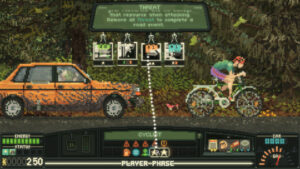
Keep Driving: A Pixel-Art Road Trip RPG That Captures the Soul of the Open Road
Released on February 6, 2025, for Windows PC via Steam, Keep Driving is an indie atmospheric management RPG developed by YCJY Games, a Gothenburg-based two-person studio consisting of Christopher Andreasson (programming) and Josef Martinovsky (art and design). Set in the early 2000s, this pixel-art gem immerses players in a procedurally generated road trip across a nostalgic, open-world landscape. With its unique blend of turn-based “combat,” resource management, and heartfelt storytelling through quirky hitchhikers, Keep Driving has earned widespread acclaim, boasting a 94% positive rating from 2,931 Steam reviews and a Metacritic score of 89, ranking it among 2025’s top games. This article explores the game’s development, gameplay, technical and artistic achievements, reception, and cultural impact, delving into why Keep Driving is a standout title that resonates with players seeking freedom, connection, and introspection on the open road.
YCJY Games began developing Keep Driving in 2016, following their earlier titles The Aquatic Adventure of the Last Human and Keep Walking EP, the latter serving as a spiritual predecessor. Conceived as their “big thing,” the game reflects the personal experiences of Andreasson and Martinovsky, who drew inspiration from their own road trips and encounters with colorful characters. The early 2000s setting was chosen to evoke a pre-smartphone era, emphasizing the raw, unfiltered freedom of navigation without GPS or social media. Influences include road trip films like Paris, Texas (1984) and Two-Lane Blacktop (1971), as well as games like FTL: Faster Than Light, Jalopy, and The Oregon Trail II. The developers even prototyped the game as a tabletop experience to refine its mechanics, ultimately settling on a roguelike-inspired RPG structure with a focus on simplicity and emotional depth.
 Initially, Keep Driving featured more complex car controls and minigames, but the team streamlined these to prioritize a meditative pace, embracing quiet moments that mirror the monotony and wonder of real road trips. The pixel-art style, inspired by Gothenburg’s landscapes and Martinovsky’s time in Los Angeles, uses eight to nine parallax layers for a dynamic, immersive backdrop. The soundtrack, featuring over 50 tracks from Swedish indie bands like Westkust, complements the game’s vibe with skate-punk and synth-wave energy. Development challenges included balancing the game’s randomized events and ensuring bug-free performance, with Andreasson as the sole programmer addressing issues via public test branches on Steam. A demo released during Steam Next Fest in October 2024 garnered significant attention, setting the stage for the full release.
Initially, Keep Driving featured more complex car controls and minigames, but the team streamlined these to prioritize a meditative pace, embracing quiet moments that mirror the monotony and wonder of real road trips. The pixel-art style, inspired by Gothenburg’s landscapes and Martinovsky’s time in Los Angeles, uses eight to nine parallax layers for a dynamic, immersive backdrop. The soundtrack, featuring over 50 tracks from Swedish indie bands like Westkust, complements the game’s vibe with skate-punk and synth-wave energy. Development challenges included balancing the game’s randomized events and ensuring bug-free performance, with Andreasson as the sole programmer addressing issues via public test branches on Steam. A demo released during Steam Next Fest in October 2024 garnered significant attention, setting the stage for the full release.
Keep Driving casts players as a young adult in the early 2000s, fresh off purchasing their first car—a beat-up sedan, pickup truck, or muscle car—and setting out for a music festival across a procedurally generated map. The narrative is minimal, serving as a backdrop for player-driven stories shaped by choices, hitchhikers, and random events. With nine distinct endings, each playthrough lasts 1–4 hours, encouraging replayability to explore alternate paths, such as inheriting property, joining a drag race, or attending a cabin party.
 The gameplay loop splits into two pillars: road travel and town stops. On the road, players navigate a side-view interface where the car drives automatically, interrupted by turn-based “combat” events like potholes, biker gangs, or errant sheep. These events threaten four resources: gasoline, cash, car durability, and energy. Players counter threats using skill cards (unlocked via a skill tree) and items from the glovebox, such as duct tape or coffee, matching colored icons to neutralize challenges. The system is simple yet strategic, requiring players to prioritize resources—e.g., sacrificing durability to preserve fuel when low on gas.
The gameplay loop splits into two pillars: road travel and town stops. On the road, players navigate a side-view interface where the car drives automatically, interrupted by turn-based “combat” events like potholes, biker gangs, or errant sheep. These events threaten four resources: gasoline, cash, car durability, and energy. Players counter threats using skill cards (unlocked via a skill tree) and items from the glovebox, such as duct tape or coffee, matching colored icons to neutralize challenges. The system is simple yet strategic, requiring players to prioritize resources—e.g., sacrificing durability to preserve fuel when low on gas.
At towns, rest stops, or outposts, players manage resources by refueling, repairing, or buying items like snacks, spare tires, or CDs for the in-game playlist. Garages offer upgrades like turbo engines or hood ornaments, while employment offices provide odd jobs to earn cash at the cost of time. The game’s map, though sometimes blurry on Steam Deck, guides navigation, with each destination listing fuel costs and available amenities.
Hitchhikers, like The Punk, The Bride, or The Hurricane, are the game’s heart, acting as RPG party members with unique skills and backstories. For example, The Hurricane clears one threat per encounter but may encourage risky behavior like shoplifting or drinking, which applies a disorienting screen effect and tightens combat timers. These characters unlock new skills as they bond with the player, revealed through text snippets or trunk interactions, adding emotional depth. Players can pursue hitchhikers’ quests, like dropping The Punk at a club, or kick them out, though some, like The Dog, may persist. The interplay of hitchhikers’ personalities—quirky, flawed, and human—creates a sense of transient friendship, reflecting the fleeting connections of youth.
 The roguelike structure rewards strategic planning. Players choose backgrounds (e.g., mechanic or student) that affect starting resources, like a parental bailout option for cash or energy shortages. Introspection events, triggered randomly, offer choices that alter stats or unlock quests, such as gaining a forest buff or a bottle of liquor to sell. Car upgrades and skills carry over in New Game+, and items like crowbars or flashlights have multiple uses, such as bypassing locked gates or caves during exploration. However, the combat system can feel repetitive after multiple runs, and the UI lacks clarity for some mechanics, like installing upgrades or managing quests.
The roguelike structure rewards strategic planning. Players choose backgrounds (e.g., mechanic or student) that affect starting resources, like a parental bailout option for cash or energy shortages. Introspection events, triggered randomly, offer choices that alter stats or unlock quests, such as gaining a forest buff or a bottle of liquor to sell. Car upgrades and skills carry over in New Game+, and items like crowbars or flashlights have multiple uses, such as bypassing locked gates or caves during exploration. However, the combat system can feel repetitive after multiple runs, and the UI lacks clarity for some mechanics, like installing upgrades or managing quests.
Keep Driving’s pixel-art aesthetic is a standout, with vibrant, multi-layered backgrounds that shift from rural fields to urban sprawls, capturing the early 2000s vibe. The UI, with its tactile dashboard and Polaroid-like skill cards, is intuitive, though some players report issues like blurry maps on Steam Deck or windowed mode glitches (fixable with Alt+Enter). The game runs smoothly on modest PCs, with minimal system requirements, and is Steam Deck-verified, though full controller support is still in development.
The soundtrack, featuring Swedish indie bands like Westkust’s “Swirl” and “Dishwasher,” is a highlight, with players able to queue up to six songs for a customizable road-trip vibe. The sound design, including engine hums and hitchhiker banter, enhances immersion. However, the lack of a dedicated music player and occasional crashes, like when accessing the trunk after certain actions, have been noted.
 1Keep Driving has been celebrated as one of 2025’s early masterpieces, earning a “Mighty” rating on OpenCritic (89/100 from 22 critics) and praise for its charm, atmosphere, and innovative mechanics. Game Rant called it “emotionally evocative,” while The Indie Informer lauded its road-trip fantasy. Posts on X highlight its pixel-art beauty and soundtrack, with fans like @JLo_Gamer and @YCJYgames praising its nostalgic vibe. Critics and players appreciate its ability to capture the freedom and aimlessness of youth, drawing comparisons to Roadwarden and Pacific Drive.
1Keep Driving has been celebrated as one of 2025’s early masterpieces, earning a “Mighty” rating on OpenCritic (89/100 from 22 critics) and praise for its charm, atmosphere, and innovative mechanics. Game Rant called it “emotionally evocative,” while The Indie Informer lauded its road-trip fantasy. Posts on X highlight its pixel-art beauty and soundtrack, with fans like @JLo_Gamer and @YCJYgames praising its nostalgic vibe. Critics and players appreciate its ability to capture the freedom and aimlessness of youth, drawing comparisons to Roadwarden and Pacific Drive.
However, some players find the gameplay repetitive after multiple runs, with similar events and hitchhikers reducing replayability. The forced end after reaching a main objective, like the festival, frustrates those expecting to continue exploring, and the lack of clear tutorials for mechanics like upgrades or seat management has drawn criticism. The inclusion of drunk driving, while penalized with harsh gameplay effects, sparked debate for its realism, with some calling it irresponsible. YCJY Games has promised patches and console ports, with a 2025 roadmap teasing new content.
The game’s minimalist narrative, while a strength for its open-ended storytelling, leaves some players disconnected from a larger story arc. The combat system, though engaging, can feel stale after extended play, and the lack of varied events or deeper car controls disappointed those expecting a freer driving experience akin to My Summer Car. Technical issues, like crashes when accessing the trunk or blurry map visuals, persist, though the small team is actively addressing them. The drunk-driving mechanic, intended to reflect real-world consequences, has been criticized for glamorizing risky behavior, though its punishing effects aim to deter it.
Keep Driving is a captivating, introspective road-trip RPG that blends resource management, turn-based combat, and heartfelt storytelling into a nostalgic early-2000s adventure. Its pixel-art world, evocative soundtrack, and quirky hitchhikers create a unique sense of freedom and connection, making every journey feel personal. Despite repetitive combat and minor technical hiccups, its charm and replayability—bolstered by nine endings and a roguelike structure—make it a standout indie title. As YCJY Games continues to refine the experience and expand to consoles, Keep Driving invites players to roll down the windows, crank the Swedish indie tunes, and embrace the open road, proving that the journey truly is the destination.

